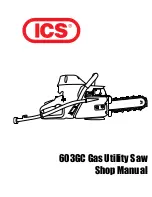
5
FEATURES
KNOW YOUR COMPOUND MITER SAW
1.
On/Off Switch and Lockout Hole: This saw
is activated by an easy to use, hand operated,
power switch. When not in use the saw should be
disconnected from the power supply and locked using a
padlock inserted through the lockout hole located on the
power switch.
2.
Safety Switch: This switch helps prevent accidental
start, must be engaged along with power switch to
operate machine.
3.
Dust Bag: The dust bag collects and contains the saw
dust during the cutting operations.
4.
Depth Stop Screw/Depth Stop Plate: The depth
stop plate can be used to make a non-through cut. The
depth stop screw allows the depth of cut to be adjusted.
5.
Bevel Scale and Indicator: These indicate the
current blade bevel position and are adjustable; This
allows for fine calibration of the blade alignment.
6.
Sliding Fence: The fence supports the workpiece when
making all cuts. The extension is adjustable.
7.
Base: Supports the tool and features mounting holes.
8.
Throat Plate (Kerf Plate): The throat plate supports
the workpiece from underneath, on both sides of the
blade, to minimize workpiece tear out
9.
Work Table: The die-cast aluminum work table
provides a level and sturdy work surface.
10.
Work Clamp: The vertical work clamp helps to position
and secure the workpiece to the work table. This
provides for safer operation and more accurate cuts.
11.
Blade: A 12 inch blade is included with the compound
miter saw.
12.
Lower Guard: The lower blade guard is made of
shock-resistant, see-through plastic that provides
protection from the blade.
13.
Spindle Lock: Engage the spindle lock when changing
the blade in order to hold the blade into position while
you loosen the blade bolt.
14.
Upper Guard: Cast aluminum protects user from blade.
15.
Back Fence Support: These provide workpiece
support and additional cut capacity when the sliding
fence is removed.
16.
T30 Torx/Blade Wrench: This wrench should be used
when removing, installing, or changing the blade.
17.
Motor End Cap: This provides access to your saw’s
motor’s Brush Caps/carbon brushes, in the event they
need to be inspected or replaced.
18.
Carrying Handle: Use this to transport your saw.
Make sure the Slide and Head lock are engaged before
transporting.
19.
Slide Lock Lever: This allows the saw head to be
locked into the fully retracted position.
20.
Saw Head Lock Pin: This allows the saw head to be
locked into the full down position, for transportation.
21.
Miter Scale and Indicator: These indicate the current
blade miter position and are adjustable; This allows for
fine calibration of the blade alignment.
22.
Miter Detent Override Button: This button holds the
miter detent into the unlocked position which allows
free movement of work table arm without holding the
miter detent lock/unlock button.
23.
Miter Lock Knob: This knob locks the blade miter
angle securely into place. Always lock before making
any cuts.
24.
Miter Detent Lock/Unlock Button: This button
allows you to release the miter arm from the positive
stops and freely rotate the miter arm.
25.
Mounting Holes (x4): Enables you to securely mount
the tool to a stable surface.
26.
Bevel Lock/Unlock Handle: This handle locks the
blade bevel angle securely into place. Always lock
before making any cuts.
27.
Bevel Detent Latch: This latch engages/disengages
the bevel detent pin which allows the bevel angle to be
locked into one of the detent positions.
28.
Slide Resistance Adjustment: This adjusts the
friction for the front to back saw head siding movement.
29.
E-Brake (Not Shown): This brake will slow your blade
down quickly when the power switch is disengaged
(release hand from power switch).
Содержание R4231
Страница 35: ...35 NOTES...






































